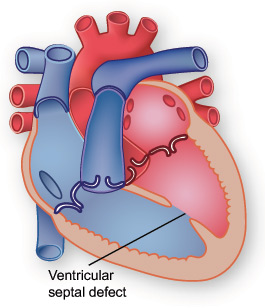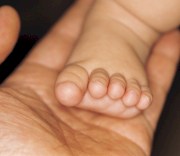A septal defect is a hole in the septum, which is the muscle wall that separates the heart's left and right chambers. A septal defect is sometimes called "a hole in the heart."

A ventricular septal defect (VSD) is a hole in the part of the septum that separates the lower chambers of the heart (the ventricles). Normally, the left ventricle pumps oxygen-rich blood into the aorta, which carries blood away from the heart and lungs to the rest of the body. But with VSD, some of the blood gets pushed through the hole into the right ventricle instead of flowing normally to the rest of the body.
From the right ventricle, the blood goes through the pulmonary artery to the lungs. The blood vessels in the lungs may become damaged by the high volume of blood being pumped into them by the right ventricle.
The left and right ventricles can also become overworked. In an attempt to supply the body with enough blood, the left ventricle may pump harder and faster than normal. This extra work can cause the heart to become enlarged.
What are the symptoms?
Symptoms of VSD may not appear until days or weeks after birth.
- Shortness of breath
- Pale skin
- Rapid breathing
- Rapid heart rate (pulse)
- Frequent respiratory infections
- Slow growth
How is it treated?
Many children with VSD do not need surgery. The hole may close naturally during the first 7 years of life, or it may be too small to cause problems.
But if the hole is large, surgery may be needed. Pulmonary artery banding is one type of surgery used to temporarily fix ventricular septal defects. It uses a band to narrow the pulmonary artery, which reduces blood flow and pressure to the lungs. Later, when the child is older, the band can be removed and the defect can be fixed with open heart surgery.
If the hole needs to be repaired, the edges of the hole may be stitched together, or it may be covered with a patch.
Return to main topic: Congenital Heart Disease
See on other sites:
MedlinePlus
https://medlineplus.gov/ency/article/001099.htm
Ventricular septal defect
Texas Adult Congenital Heart Center (TACH)
www.bcm.edu/healthcare/care-centers/congenital-heart
This Baylor College of Medicine program enables patients with congenital heart disease to receive a seamless continuation of care from birth to old age.
Updated August 2016



